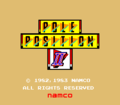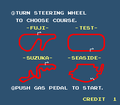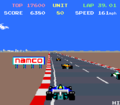m (Cleanup) |
BrownDerby (talk | contribs) (arcade archives) |
||
| (14 intermediate revisions by 10 users not shown) | |||
| Line 1: | Line 1: | ||
{{Header Bar|game=Pole Position II}} | |||
{{Header | {{Game | ||
{{ | |completion=2 | ||
|image=Pole Position II JP flyer.jpg | |||
|title=Pole Position II | |title=Pole Position II | ||
| | |japanese=ポールポジション II | ||
|developer=[[Namco]] | |developer=[[Namco]] | ||
|publisher={{ | |publisher={{colist|Namco|Atari}} | ||
| | |year=1983 | ||
|systems={{syslist|cade|a7800|scv|c64|msdos}} | |||
|title1=Arcade Archives Pole Position II | |||
|developer1=[[Namco]] | |||
|publisher1=[[Hamster Corporation]] | |||
|year1=2023 | |||
|systems1={{syslist|switch|ps4}} | |||
|ratings1={{IARC|3}}{{ESRB|E}}{{PEGI|3}}{{ACB|G}} | |||
|genre=[[Racing]] | |genre=[[Racing]] | ||
|players=1 | |players=1 | ||
|modes=[[Single player]] | |||
|preceded by=[[Pole Position]] | |preceded by=[[Pole Position]] | ||
| | |series=Pole Position | ||
|series2=Arcade Archives | |||
|pcgamingwiki=Pole Position II | |||
}} | }} | ||
{{ | {{marquee|Pole Position II marquee.png}} | ||
'''Pole Position II''' was more of an update than a true sequel to | '''Pole Position II''' was more of an update than a true sequel to Toru Iwatani's original [[Pole Position]]. It features three new race tracks, in addition to the original Fuji Speedway - Suzuka, Seaside (which resembles Long Beach), and a Test circuit (which resembles Indianapolis). It also contains a slight increase in the amount of color variation to indicate the difference between tracks. The cars also have a different color scheme and the explosions now show debris. This sequel also featured "striped" roads; a graphic characteristic designed to give the game a greater sensation of speed, and something that would be copied, and used to great effect, many times in the racing games that followed over subsequent years. Other than these changes, the gameplay is identical to the original and runs on the same hardware (a Zilog Z80 and two Zilog Z8002 microprocessors run at 3.072 MHz), and has stereo sound. | ||
As with the original Pole Position, this game could either be found in a standard upright cabinet format, or in a sit-down cockpit environment cabinet for a heightened realism. As before, [[Atari]] was granted the rights by [[Namco]], to distribute the game in North America. Unlike the original arcade game, Atari did not port the game to several systems. A version was developed to showcase the graphical capabilities of the [[Atari 7800]] in 1984, but when the Tramiels purchased Atari, they halted all further development of home consoles in favor of expanding their Atari [[Atari 8-bit|home computer line]]. When the [[Nintendo Entertainment System]] resurrected the American home console market, Atari resumed their plans to launch the Atari 7800, with Pole Position II as the system's pack-in game, but Atari simply failed to compete with Nintendo. It was not due to the age of their technology either - the Atari 7800 had been designed in 1984 while the Famicom had been designed in 1983. | |||
<gallery> | <gallery> | ||
File:Pole Position II title.png|Namco title screen. | |||
File:Pole Position II tracks.png|The track selection screen. | |||
File:Pole Position II screen.png|Racing upon the "Test" track. | |||
File:Pole Position II flyer.jpg|Atari arcade flyer. | |||
File:Pole Position II logo.png|Logo. | |||
</gallery> | </gallery> | ||
{{-}} | {{-}} | ||
== | ==Versions== | ||
Despite being an improved version of the original, Pole Position II was only released on two systems. It was included as the pack-in game with every [[Atari 7800]], so it is quite common. | |||
Despite being an improved version of the original, Pole Position II was only released on | |||
<gallery> | <gallery> | ||
File:Pole Position II 7800 box.jpg|Atari 7800 box | |||
File:Pole Position II 7800.png|Atari 7800 screenshot | |||
File:Pole Position II C64 box.jpg|Commodore 64 box | |||
File:Pole Position II C64.png|Commodore 64 screenshot | |||
</gallery> | </gallery> | ||
==Trophies== | |||
{{Arcade Archives trophies|10,000|20,000|30,000}} | |||
[[Category: | {{Pole Position}} | ||
[[Category: | |||
[[Category:Namco]] | |||
[[Category:Hamster Corporation]] | |||
[[Category:Racing]] | [[Category:Racing]] | ||
[[Category:Single player]] | [[Category:Single player]] | ||
[[Category: | [[Category:MAME]] | ||
Latest revision as of 04:31, 7 December 2023

| Pole Position II | |
|---|---|
| Developer(s) | Namco |
| Publisher(s) | Namco, Atari |
| Year released | 1983 |
| System(s) | Arcade, Atari 7800, Epoch Super Cassette Vision, Commodore 64/128, DOS |
| Preceded by | Pole Position |
| Series | Pole Position, Arcade Archives |
| Japanese title | ポールポジション II |
|---|---|
| Genre(s) | Racing |
| Players | 1 |
| Modes | Single player |
| Arcade Archives Pole Position II | |
|---|---|
| Developer(s) | Namco |
| Publisher(s) | Hamster Corporation |
| Year released | 2023 |
| System(s) | Nintendo Switch, PlayStation 4 |
| Rating(s) | |
Pole Position II was more of an update than a true sequel to Toru Iwatani's original Pole Position. It features three new race tracks, in addition to the original Fuji Speedway - Suzuka, Seaside (which resembles Long Beach), and a Test circuit (which resembles Indianapolis). It also contains a slight increase in the amount of color variation to indicate the difference between tracks. The cars also have a different color scheme and the explosions now show debris. This sequel also featured "striped" roads; a graphic characteristic designed to give the game a greater sensation of speed, and something that would be copied, and used to great effect, many times in the racing games that followed over subsequent years. Other than these changes, the gameplay is identical to the original and runs on the same hardware (a Zilog Z80 and two Zilog Z8002 microprocessors run at 3.072 MHz), and has stereo sound.
As with the original Pole Position, this game could either be found in a standard upright cabinet format, or in a sit-down cockpit environment cabinet for a heightened realism. As before, Atari was granted the rights by Namco, to distribute the game in North America. Unlike the original arcade game, Atari did not port the game to several systems. A version was developed to showcase the graphical capabilities of the Atari 7800 in 1984, but when the Tramiels purchased Atari, they halted all further development of home consoles in favor of expanding their Atari home computer line. When the Nintendo Entertainment System resurrected the American home console market, Atari resumed their plans to launch the Atari 7800, with Pole Position II as the system's pack-in game, but Atari simply failed to compete with Nintendo. It was not due to the age of their technology either - the Atari 7800 had been designed in 1984 while the Famicom had been designed in 1983.
-
Namco title screen.
-
The track selection screen.
-
Racing upon the "Test" track.
-
Atari arcade flyer.
-
Logo.
Versions[edit]
Despite being an improved version of the original, Pole Position II was only released on two systems. It was included as the pack-in game with every Atari 7800, so it is quite common.
-
Atari 7800 box
-
Atari 7800 screenshot
-
Commodore 64 box
-
Commodore 64 screenshot
Trophies[edit]
| 6 | |||
| 1 | 3 | 2 | |
There are six trophies for PlayStation 4.















